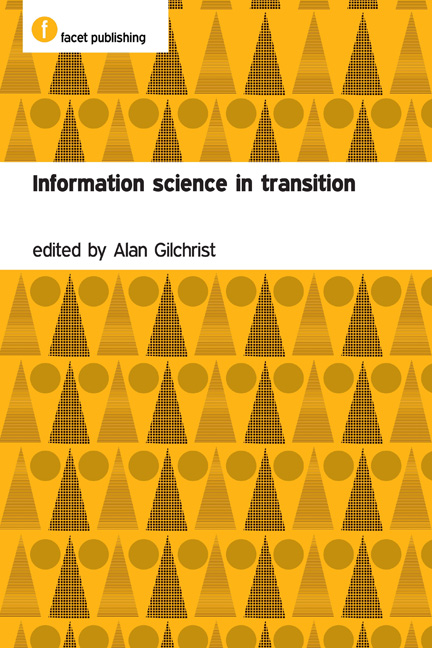Book contents
- Frontmatter
- Contents
- Contributors
- Preface
- Editorial
- Guest Editorial: Meeting the challenge
- 1 Fifty years of UK research in information science
- 2 Smoother pebbles and the shoulders of giants: the developing foundations of information science
- 3 The last 50 years of knowledge organization: a journey through my personal archives
- 4 On the history of evaluation in IR
- 5 The information user: past, present and future
- 6 The sociological turn in information science
- 7 From chemical documentation to chemoinformatics: 50 years of chemical information science
- 8 Health informatics: current issues and challenges
- 9 Social informatics and sociotechnical research – a view from the UK
- 10 The evolution of visual information retrieval
- 11 Information policies: yesterday, today, tomorrow
- 12 The disparity in professional qualifications and progress in information handling: a European perspective
- 13 Electronic scholarly publishing and Open Access
- 14 Social software: fun and games, or business tools?
- 15 Bibliometrics to webometrics
- 16 How I learned to love the Brits
- Index
3 - The last 50 years of knowledge organization: a journey through my personal archives
Published online by Cambridge University Press: 08 June 2018
- Frontmatter
- Contents
- Contributors
- Preface
- Editorial
- Guest Editorial: Meeting the challenge
- 1 Fifty years of UK research in information science
- 2 Smoother pebbles and the shoulders of giants: the developing foundations of information science
- 3 The last 50 years of knowledge organization: a journey through my personal archives
- 4 On the history of evaluation in IR
- 5 The information user: past, present and future
- 6 The sociological turn in information science
- 7 From chemical documentation to chemoinformatics: 50 years of chemical information science
- 8 Health informatics: current issues and challenges
- 9 Social informatics and sociotechnical research – a view from the UK
- 10 The evolution of visual information retrieval
- 11 Information policies: yesterday, today, tomorrow
- 12 The disparity in professional qualifications and progress in information handling: a European perspective
- 13 Electronic scholarly publishing and Open Access
- 14 Social software: fun and games, or business tools?
- 15 Bibliometrics to webometrics
- 16 How I learned to love the Brits
- Index
Summary
Abstract
At the time when the Institute of Information Scientists was launched, well established principles of classification, especially faceted classification, provided an excellent springboard for developments in knowledge organization thereafter. The principles of thesaurus construction and use were worked out during the first two decades of the Institute's existence. Up until the end of the 1980s, most practical systems to exploit any of these vocabularies were held on cards, some of them highly ingenious. The subsequent arrival of the desktop computer, soon followed by the growth of networks providing access to an almost unimaginable quantity and variety of resources, has stimulated evolution of the knowledge organization schemes to exploit the technology available. Anecdotes of events and practical applications of controlled vocabularies illustrate this account of developments over the period.
Introduction
The last 50 years is just a blip in the history of knowledge organization, if you take the story back to the Library of Alexandria in the third century BC, with its shelf arrangement designed by Callimachus and probably inspired by Aristotle [1]. However, the period from 1958 onwards has seen a major shift in the focus of interest, and more than one transformation in the practicalities of how we apply the principles.
A systematic review of developments would be too ambitious for this article. Instead it juxtaposes an account of some milestone advances in the period, together with anecdotes illustrating how it felt to work in those times. ‘Principles and practice’, the byline of the Journal of Information Science, seems a fair summary of the approach.
The run-up to 1958, or, the rise and rise of Classification
By the time the Institute of Information Scientists was launched, the theory and pioneering development of classification schemes had seen their heyday.
The problems of an enumerative scheme such as the Dewey Decimal Classification Scheme were well known. (See Berwick Sayers in 1956 [1]: ‘The curious fact remains that more and more libraries throughout the world continue to use it […] somehow it works.
- Type
- Chapter
- Information
- Information Science in Transition , pp. 45 - 62Publisher: FacetPrint publication year: 2009



